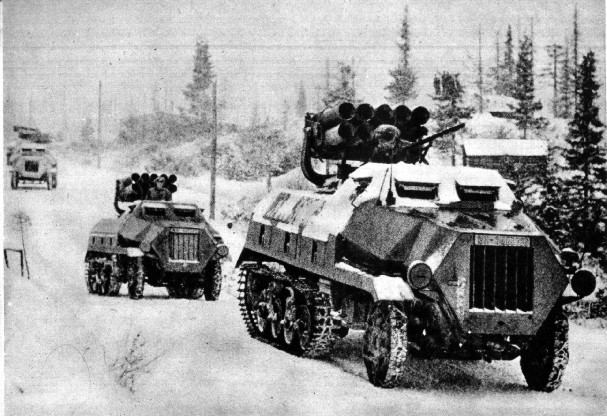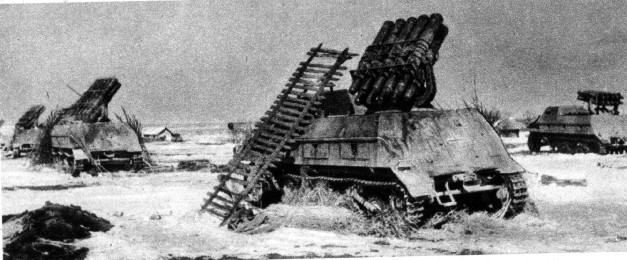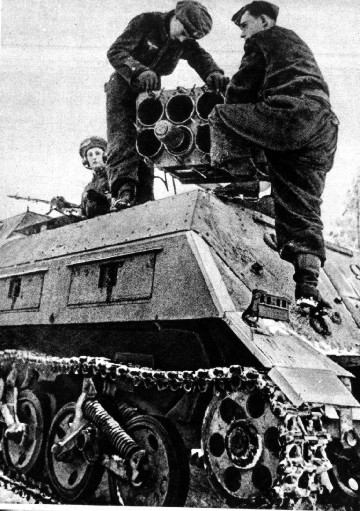| |
Panzerwerfer 42 auf Maultier
in Action
by Stephan Ward

At the hobby shop about a year ago I saw an Italeri
kit of something called the Panzerwerfer 42. I had read about it
in some vague references in a few books on German vehicles before, and
it looked like a cool kit to build. So I bought it, took it home,
and started my research, something I do before I build any model.
I turned up nothing at first. It took half a year before I had reference
material that was applicable. After almost a year it was finished,
the product of countless hours of research, modifications to the kit,
and superdetailing, and which turned out to be the toughest armor model
I’d ever built, due to the considerable inaccuracies and lack of easily
available published information on it. That’s why I decided this
article was something I needed to write, to provide other modelers with
some rare pictures, and, through it’s combat history, explain some about
the vehicle.
The Panzerwerfer 42 auf Maultier, Sd.Kfz. 4/1, first
went into production in April of 1943, and was produced until March of
1945. Hitler called for production of the vehicle in January of
1942, and the vehicle saw it’s first tests on the front in fall of 1943.
The rocket launcher was on a chassis referred to as "Maultier",
which means "Mule". The vehicle is referred to with the
suffix "42", but all of the German texts about the vehicle refer
to it as the Panzerwerfer 43, a reference to it’s first year of production.
Opel was the main manufacturer, producing most of the components, including
the 3.6 liter, 6 cylinder Adam Opel engine, which had 68 horsepower and
an 80 liter fuel capacity, Throughout the three years it was produced,
300 Panzerwerfers and 289 of it’s variant, the Munitionkraftswagen, were
made. The Munitionkraftswagen, or Sd.Kfz. 4, was the exact same
vehicle, just without the rocket launcher. It was mainly used for
ammo re-supply. The Panzerwerfer had a 150-millimeter, 10-barrel
rocket launcher, which traversed 270 degrees, could be elevated up to
80 degrees, and was guided with the RA35 optical sight. It had a
crew of three, a commander, who was also the driver, a radio operator,
and a gunner.
There were other variations of the vehicle too.
Throughout the years in production, there were changes in armoring and
suspension, along with small changes in the shape and thickness of the
steel armor, resulting in three specific variants of the vehicle.

The 150mm launcher was not
the only rocket launcher mounted on the Maultier chassis. The 24
rail Vielfachwerfer, or "multiple rocket launcher", was also
mounted on the vehicle. It used the same cupola base as the standard
launcher, just with a smaller, 80mm launcher. This was the version
used by SS Werfer units, and not the Wehrmacht’s Maultier rocket launcher
battalions. One unit was SS Werfer Brigade 506, who was equipped
with 24 rail Vielfachwerfers, some mounted on French halftrack chassis
similar in shape and armoring to the Opel Maultier armored halftrack.
The Panzerwerfer saw action on both fronts, seeing
it’s first combat in Russia in late 1943. As to whether it saw action
at Kursk, there is not enough solid information to support that but it
is very possible. There is some evidence that some early launcher
prototypes were field tested in battles near Kursk, but that is based
only on a few written accounts, and there are no photos that show the
vehicle there in combat. The rocket launcher was used for larger
scale rocket barrages against positions of Russian resistance where a
large bombardment of a big area would be more effective than more accurate
artillery fire. The Panzerwerfer’s rocket barrages covered much
larger areas and added more psychological elements to the fight: the amount
of noise, smoke, shrapnel, and flying debris as the rockets hit and exploded
was tremendous. The extensive use on the eastern front showed that
this weapon could be employed effectively on the western front as well.
The weapon was finally introduced throughout the army on May 14, 1944,
in France.
When the western Allies first went into action against
this weapon after D-Day, they too would learn about the effects of the
multiple rocket launcher. American intelligence before D-Day pointed
to the use of rocket launchers such as the Nebelwerfer by the German Wehrmacht,
but besides that, they were overly unprepared for the effects of a mobile,
armored, camouflaged, and highly destructive rocket launcher mounted on
a halftrack chassis. The British and Canadians were the first of
the western Allies to see the German rocket launchers in action against
troop concentrations and Allied positions. The 7th Werfer
Brigade was sent to Normandy from Beauvais after D-Day, and on June 10
it was in Falaise. The next day, the unit was about 10 kilometers
from Caen. The unit was part of the attack on the Orne Bridge, which
was a British held position over the Orne River. The 84th
Regiment of the brigade, which was made up of the 83rd and
84th Regiments, had fourteen combat ready Panzerwerfers, and
the 83rd had about the same. Some other Werfer units
were the 101st SS Werfer Abteilung, 101st Stellungs-Werfer
Regiment, and the SS Werfer Abteilung 102, which was part of the 2nd
SS Panzer Division, Das Reich. The British were usually at the receiving
end of the Panzerwerfers rockets in Normandy, but the 15cm Nebelwerfers
were used in large numbers against American, British, and Canadian troops
throughout the summer of 1944.

The Battle of the Bulge
was the proverbial "stomping ground" of German armored rocket
launchers during World War Two. The most concentrated, massed salvos
were used in the Ardennes during the weeks of the German offensive.
Some of the few pictures that exist of the Panzerwerfer in action were
taken during late 1944 and early 1945 in the Ardennes region of Belgium.
Rocket launchers saw extensive
use during April and May of 1945, as the Russians were quickly advancing
on Berlin and the Germans were more often on the receiving end of the
defeat. Panzerwerfers were used in large numbers defending positions
inside of Germany and close to Berlin as the Russians advanced from the
east and the Americans from the west. The majority of these vehicles
met their end at the hands of the approaching Russian army. Many
films of the battles in Berlin were taken in the last weeks of March and
into the first weeks of April 1945, and there are many taken at night
showing the firing of multiple rocket barrages. Many of the films
are of the Russian Katyusha truck mounted rocket launchers’ rockets, but
many show the Panzerwerfer’s rockets too.
The Panzerwerfer was a dangerous and destructive weapon,
but it had many disadvantages that were obvious once you looked past the
power of the weapon it was equipped with. The weight of the vehicle
was it’s main disadvantage, as the chassis, armored body, rocket launcher,
ammo, and an extra salvo of ammo brought the weight above seven tons.
Its speed on the road was about 40 km per hour, and off-road its top speed
was only about 20 km per hour on reasonable terrain. The "Horstmann"
Carden-Lloyd suspension, wheels, and tracks were simple and didn’t require
much maintenance, since the track links were the same as the Panzer I’s.
Due to the weight of the vehicle the climbing and fording ability was
minimal. It’s ground clearance was only about a foot, which made
traversing tough terrain much more of a challenge than if it was a fully
tracked vehicle. This was its advantage in operating on the Russian
steppes, as the naturally flat terrain of Russia was to the vehicles advantage.
Creeks and streams less than two feet deep were the most that could be
crossed. The Panzerwerfer was 7 ½ feet tall, 6 2/3
feet wide, and 18 feet long.
The rockets the launcher used had only one disadvantage,
which was range. The effective range for a Panzerwerfer’s rockets
was about 4,000-6,500 meters, and the maximum range was less than 7,000.
In Normandy, it was an example of the ineffectiveness of a massed bombardment
weapon. A large portion of the salvos fired at troop concentrations
missed their mark by hundreds or thousands of feet. The metal rocket
casings were thin, which created a large amount of shrapnel on impact,
but due to the thin metal used the shrapnel effect was not as deadly as
it was intented to be. The weapon caused more chaos than mass casualties.
Combat tactics usually called for a group of three to six vehicles to
mass fire on a specified position, but on many occassions crews operated
from different locations but within the same firing range to reach a predetermined
target. Very few Panzerwerfers that were captured by the Allies
were captured in any quantity. Photographs of the vehicles taken
my German PK (propaganda) photographers generally showed groups of vehicles
at staging areas, usually loading the launchers with rockets in preparation
for an attack.
When World War Two ended, there were very few Panzerwerfers
left in the world. Today, there are even fewer. The best example
of one is at the Saumur Tank Museum in Anjou, France. It has been
restored to running condition, with most of its original interior and
exterior parts intact, including the 15cm Nebelwerfer 41 rocket launcher.
Its tires are about the only post war part of the vehicle, being of British
manufacture, leading to the belief that this vehicle was captured by the
British, who after capturing it installed new tires, possibly for transport.
There is also an intact 15cm Nebelwerfer 41 rocket launcher from a Panzerwerfer
in Koblenz, Germany, at the Wehrtechnische Studiensammlug. Most
Panzerwerfers were destroyed on the Eastern Front, and American and British
units captured or destroyed many of them during Operation Overlord and
during Operation Cobra. A few were captured in the last months of
the war in southern Germany by American infantry units who marked them
and passed them onto field intelligence units who eventually used the
information gathered from them to publish late and post war technical
intelligence manuals on German vehicles.
That’s the story of the
Panzerwerfer, but at the same time it’s the same story as many other rare
vehicles of World War Two – really cool, but at the same time tough to
find anything about it without a heck of a lot of research.
A lot of thanks go to my buddy Andreas Altenburger for providing me with
unpublished pictures from Singal Magazine. Also appreciation to
Dave Zimmer for helping me out with some great pictures throughout the
course of my research.
|
|